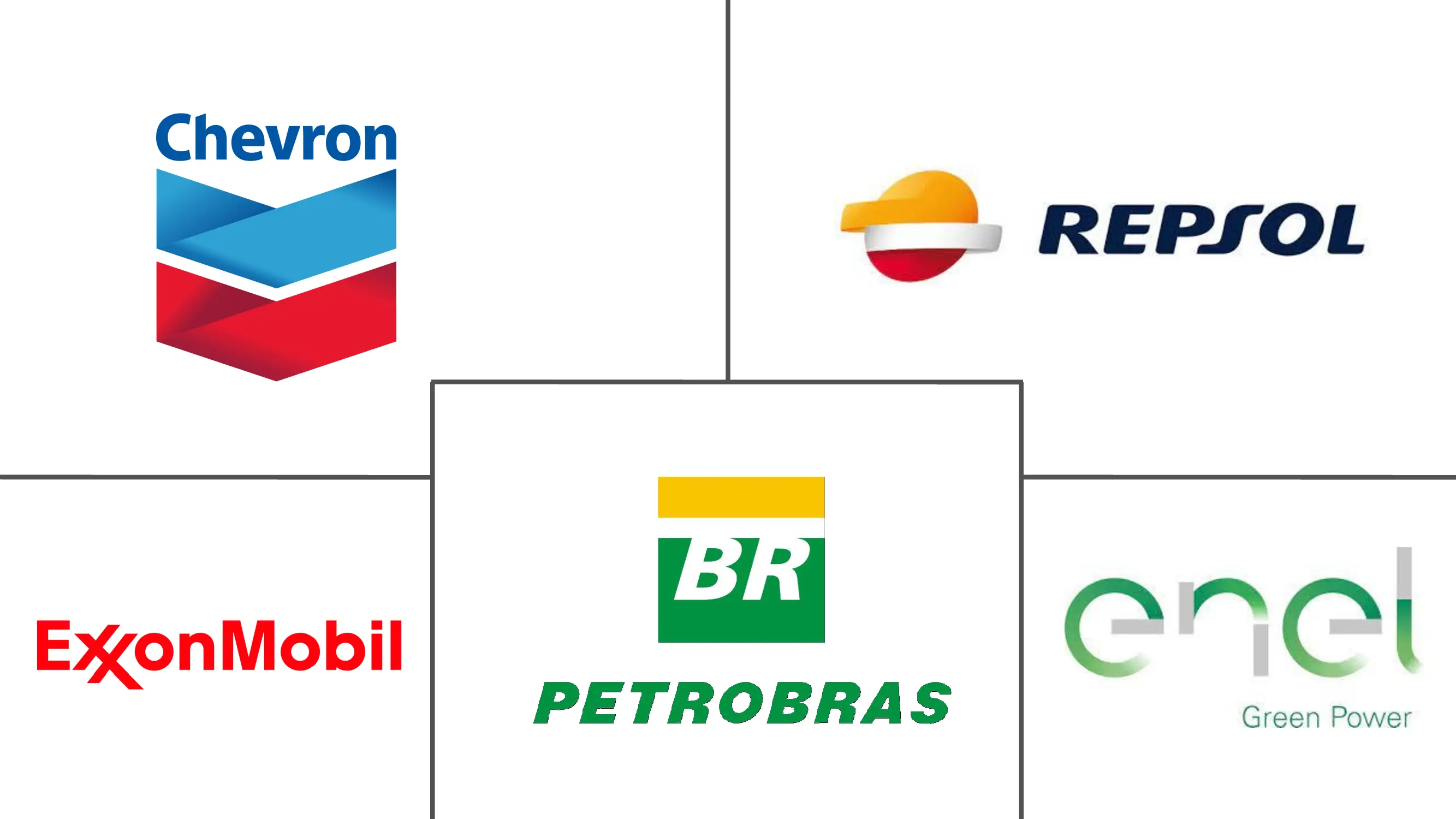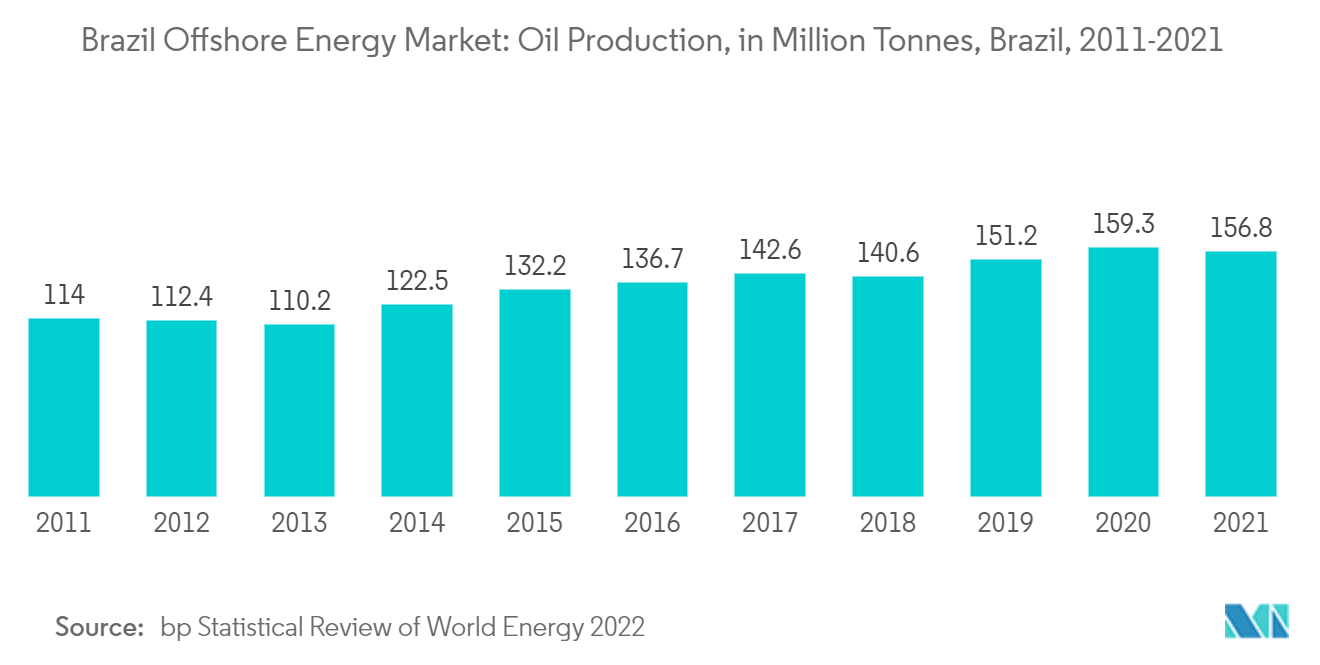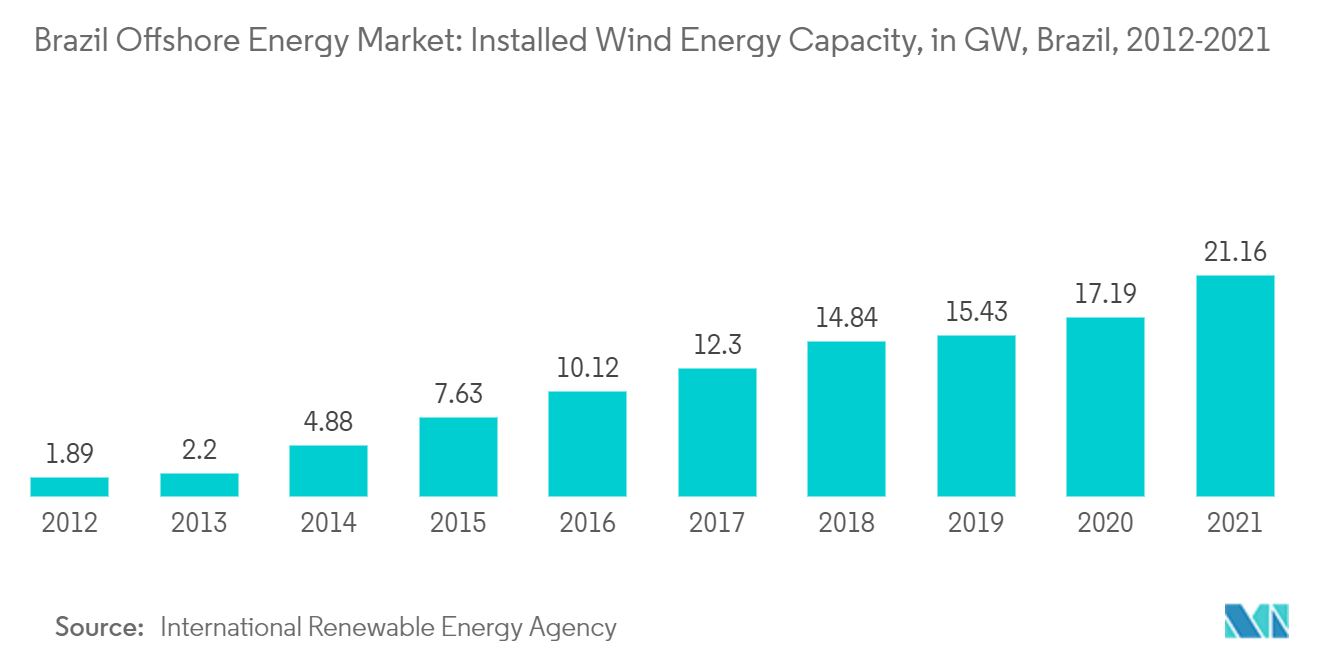Brazil Offshore Energy Market Size

| Study Period | 2019 - 2029 |
| Base Year For Estimation | 2023 |
| Forecast Data Period | 2024 - 2029 |
| Historical Data Period | 2019 - 2022 |
| CAGR | 4.00 % |
| Market Concentration | Medium |
Major Players
*Disclaimer: Major Players sorted in no particular order |
Brazil Offshore Energy Market Analysis
The Brazilian offshore energy market is projected to register a CAGR of over 4% during the forecast period.
The market was negatively impacted by COVID-19 in 2020. Presently, the market has reached pre-pandemic levels.
Over the medium term, factors such as the new government policies for developing offshore renewable energy in the country are expected to drive the offshore energy market in the forecast period. On the other hand, the higher initial investment required in the offshore establishment is expected to restrain the growth of the offshore energy market.
Nevertheless, a growing number of government policies and research initiatives are targeting the exploitation of renewable energy resources in order to meet the increasing demand for electricity and diversify the power supply. In Brazil, tidal energy is an example of this, as it has significant potential and is concentrated mainly on the coasts of the different parts of the country. It offers significant growth opportunities for the offshore energy market players in the coming years.
Brazil Offshore Energy Market Trends
This section covers the major market trends shaping the Brazil Offshore Energy Market according to our research experts:
The Oil and Gas Segment is Expected to Dominate the market
Offshore oil and gas production, which involves extracting oil and gas from the seabed, is one of the most important components of the world's energy supply. It requires the use of increasingly sophisticated technological methods and greater attention to environmental elements.
Brazil's exploration and production activity has shown significant growth during 2021, resulting in increased spending on oilfield services. The growth during the last year mainly came from the offshore sector. The increased spending on oilfield services can be related to increased drilling and completion practices. These are expected to drive the offshore energy market.
Brazil has several large-scale offshore upstream projects in the pipeline. The country is expected to contribute more than 20% of global offshore crude oil and condensate production by 2025. The majority of the production is expected to come from the Pão de Açúcar in the Campos basin and Carcará fields.
As of June 2022, there are around 7 active rigs operating in the offshore areas and 3 active rigs in the onshore areas of the country. As of 2021, floating assets, such as Floating Production Storage and Offloading (FPSO), Drillships, semi-submersibles, and Floating Storage and Offloading (FSO), accounted for more than 80% of the active offshore platforms in the country. This, in turn, indicates the dominance of offshore floating assets in Brazil's upstream oil and gas industry.
Petrobras has plans to invest around USD 68 billion for the period 2022 to 2026. Of this total investment, 84% is allocated to the exploration and production (E&P) of oil and natural gas. Of the total E&P CAPEX (USD 57 billion), around 67% will be allocated to pre-salt assets. This indicates that the upstream oil and gas sector, especially the offshore oil and gas assets in Brazil, are expected to receive significant investment during the forecast period.
It has been observed that the production for oil in Brazil has increased significantly in recent years. In 2021, the country's total natural gas production reached 156.8 million tonnes, representing an increase of about 3.7% over 2019. In view of these factors, the ongoing investments and developments in offshore oil and gas industry in the country is expected to dominate the market during the forecast period.

Government Initiatives to Develop Offshore Renewable Energy
As reported by the national statistics agency and Central Bank, Brazil's GDP increased by 4.6% in 2021. This had a direct impact on electricity consumption, which increased by 4.1% from the previous year.
In Brazil, wind energy has seen virtuous growth in the last decade, jumping from 1.89 GW in 2012 to 21.16 GW by 2021. Currently, wind energy accounts for 11% of the country's electricity generation.
GWEC participated with ABEEólica in the development of a regulatory framework for offshore wind in Brazil in 2021, marking a milestone in the implementation of offshore wind in Brazil. By the beginning of 2022, the long-awaited Decree No. 10,946/2022 was published, providing for the transfer of physical spaces and the utilization of natural resources for offshore power generation. This document, which came into force in June 2022, provides a positive signal to the market to begin the process of developing the first offshore wind projects.
According to the Brazilian Institute of the Environment and Renewable Natural Resources (IBAMA), investors are now paying attention to Brazil, resulting in licensing requests for more than 80 GW of offshore wind projects. In Brazil, the technical resource potential is estimated to be more than 700 GW, according to Energy Expansion Plan (EPE) roadmap. Furthermore, EPE estimates that Brazil will reach 16 GW of offshore wind capacity by 2050, with a 20% reduction in capital expenditures.
In November 2022, as part of a memorandum of understanding (MoU), Prumo and TotalEnergies agreed to conduct studies for the installation of logistic bases to support offshore wind projects within the Açu port area of Rio de Janeiro, Brazil. In accordance with the agreement, TotalEnergies will conduct feasibility studies for offshore wind farms with capacities of up to 3 gigawatts in the immediate vicinity of the port over the next two years.
These government initiatives and developments are anticipated to drive the offshore energy market in the country.

Brazil Offshore Energy Industry Overview
The Brazilian offshore energy market is moderately fragmented. Some of the major players (in no particular order) are Chevron Corporation, Repsol SA, Petrobras, Exxon Mobil Corporation, and Enel Green Power SpA.
Brazil Offshore Energy Market Leaders
-
Chevron Corporation
-
Repsol SA
-
Petrobras
-
Exxon Mobil Corporation
-
Enel Green Power S.p.A.
*Disclaimer: Major Players sorted in no particular order
.webp)
Brazil Offshore Energy Market News
- June 2022: Corio Generation intended to develop five offshore wind projects in Brazil with a combined capacity of more than 5 GW. Servtec, a Brazilian power generation company, will develop the five projects with Corio.
- May 2022: Petrobras and Equinor evaluated the feasibility of an offshore wind farm with a capacity of 4 GW near Aracatu, southeast Brazil. This partnership follows the signing of a Memorandum of Understanding (MoU) between the two companies in 2018. Equinor submitted an application for environmental characterization for Aracatu offshore wind farm two years before Equinor signed the MoU.
Brazil Offshore Energy Market Report - Table of Contents
1. INTRODUCTION
- 1.1 Scope of the Study
- 1.2 Market Definition
- 1.3 Study Assumptions
2. EXECUTIVE SUMMARY
3. RESEARCH METHODOLOGY
4. MARKET OVERVIEW
- 4.1 Introduction
- 4.2 Market Size and Demand Forecast in USD Million, till 2027
- 4.3 Recent Trends and Developments
- 4.4 Government Policies and Regulations
-
4.5 Market Dynamics
- 4.5.1 Drivers
- 4.5.2 Restraints
- 4.6 Supply Chain Analysis
- 4.7 PESTLE Analysis
5. MARKET SEGMENTATION
-
5.1 Type
- 5.1.1 Wind
- 5.1.2 Oil and Gas
- 5.1.3 Wave
6. COMPETITIVE LANDSCAPE
- 6.1 Mergers and Acquisitions, Joint Ventures, Collaborations, and Agreements
- 6.2 Strategies Adopted by Leading Players
-
6.3 Company Profiles
- 6.3.1 Chevron Corporation
- 6.3.2 Repsol SA
- 6.3.3 Petrobras
- 6.3.4 Exxon Mobil Corporation
- 6.3.5 Enel Green Power SpA
- 6.3.6 Eco Wave Power Global
- 6.3.7 Acciona Energia SA
- 6.3.8 Siemens Gamesa Renewable Energy SA
- 6.3.9 Vestas Wind Systems A/S
- 6.3.10 General Electric Company
- *List Not Exhaustive
7. MARKET OPPORTUNITIES AND FUTURE TRENDS
** Subject To AvailablityBrazil Offshore Energy Industry Segmentation
The term offshore renewable energy refers to the generation of electricity via ocean-based resources, such as wind turbines located offshore in the oceans and Great Lakes, as well as marine-based energy sources, such as waves, tides, salinity, and temperature. Offshore oil and gas production, which involves extracting oil and gas from the seabed, is one of the most important components of the world's energy supply. It requires the use of increasingly sophisticated technological methods and greater attention to environmental elements.
The offshore energy market is segmented by type into wind, oil and gas, and tidal. For each segment, the report offers the market size and forecasts in terms of value in USD million.
| Type | Wind |
| Oil and Gas | |
| Wave |
Brazil Offshore Energy Market Research FAQs
What is the current Brazil Offshore Energy Market size?
The Brazil Offshore Energy Market is projected to register a CAGR of greater than 4% during the forecast period (2024-2029)
Who are the key players in Brazil Offshore Energy Market?
Chevron Corporation, Repsol SA, Petrobras, Exxon Mobil Corporation and Enel Green Power S.p.A. are the major companies operating in the Brazil Offshore Energy Market.
What years does this Brazil Offshore Energy Market cover?
The report covers the Brazil Offshore Energy Market historical market size for years: 2019, 2020, 2021, 2022 and 2023. The report also forecasts the Brazil Offshore Energy Market size for years: 2024, 2025, 2026, 2027, 2028 and 2029.
Brazil Offshore Energy Industry Report
Statistics for the 2024 Brazil Offshore Energy market share, size and revenue growth rate, created by Mordor Intelligence™ Industry Reports. Brazil Offshore Energy analysis includes a market forecast outlook to 2029 and historical overview. Get a sample of this industry analysis as a free report PDF download.



